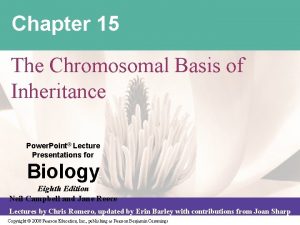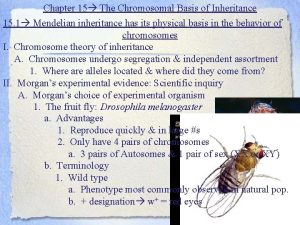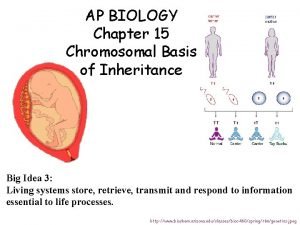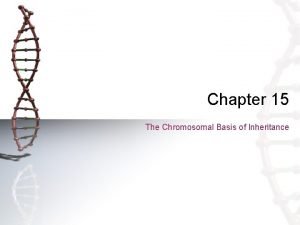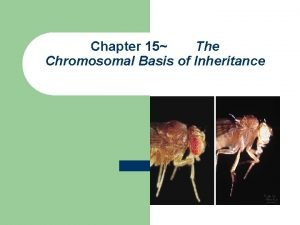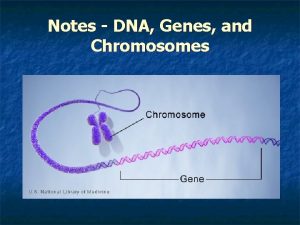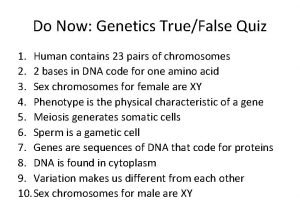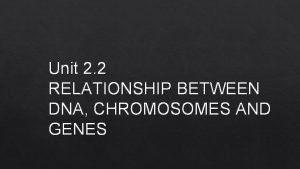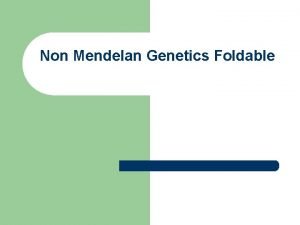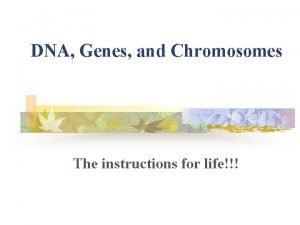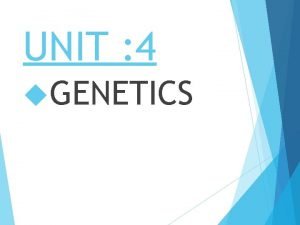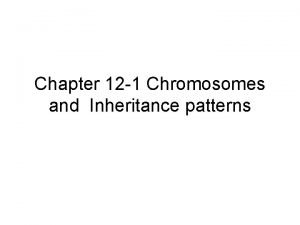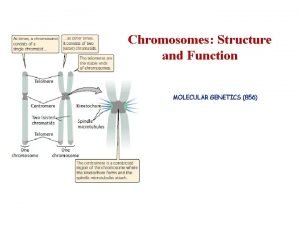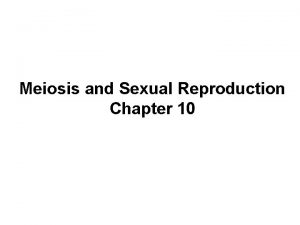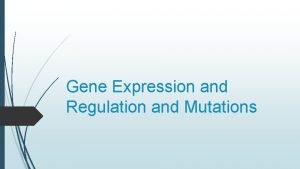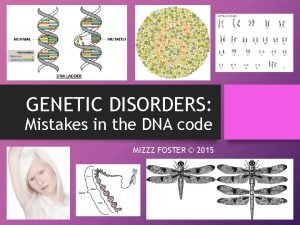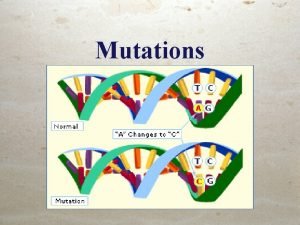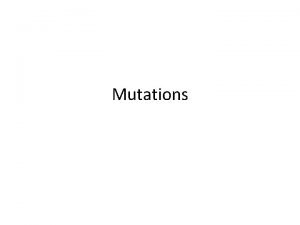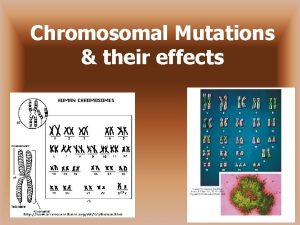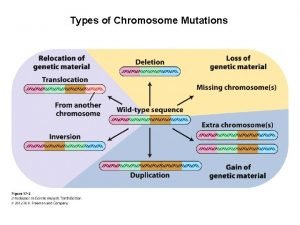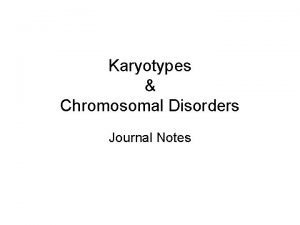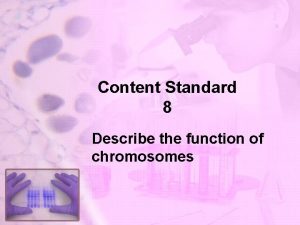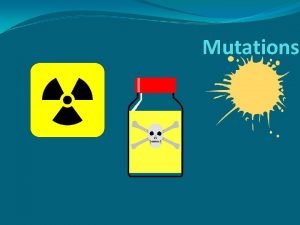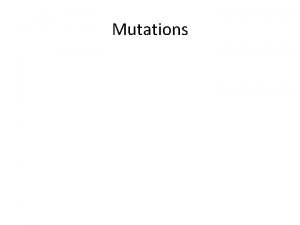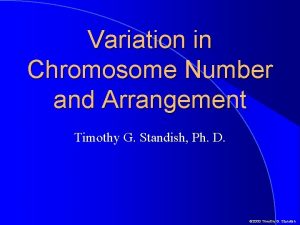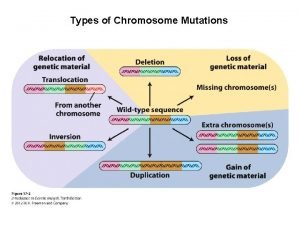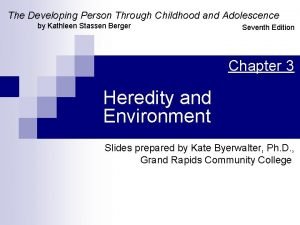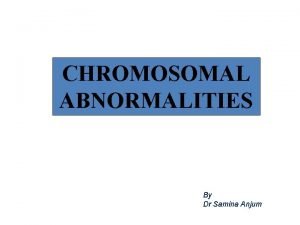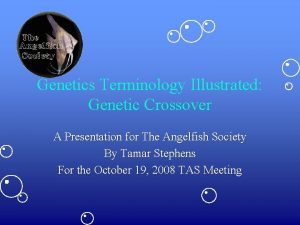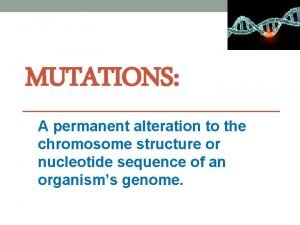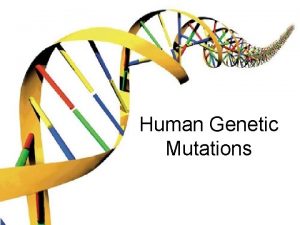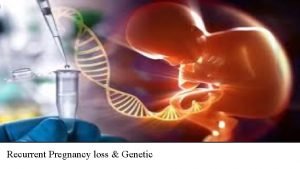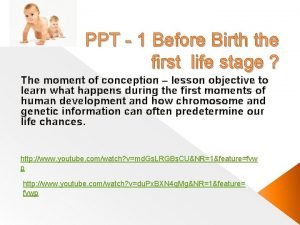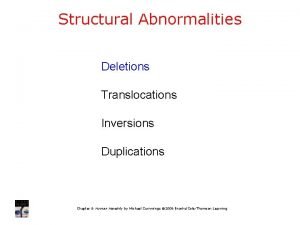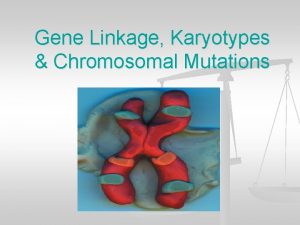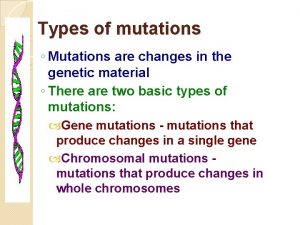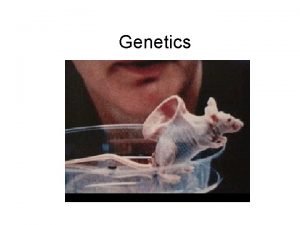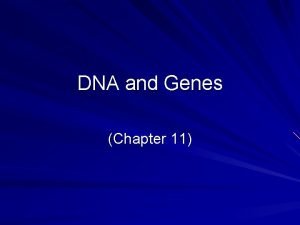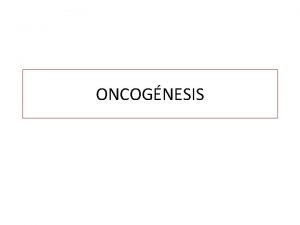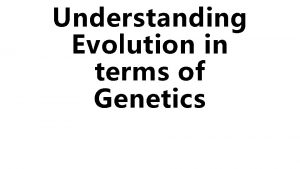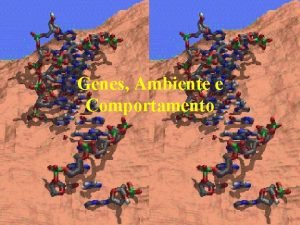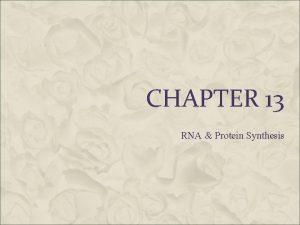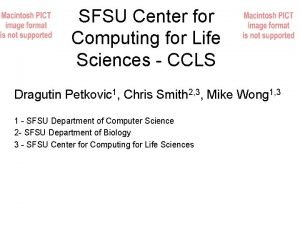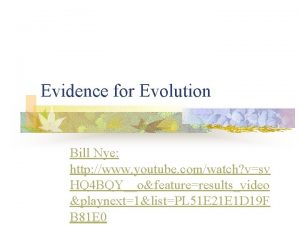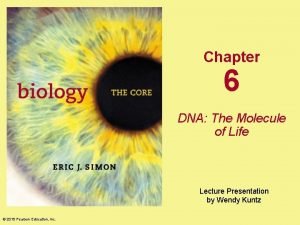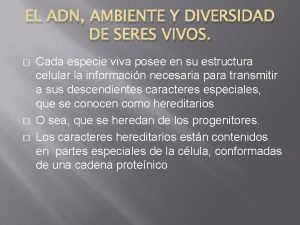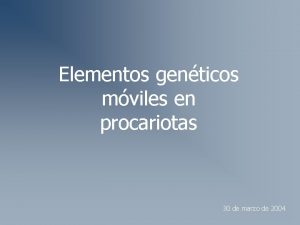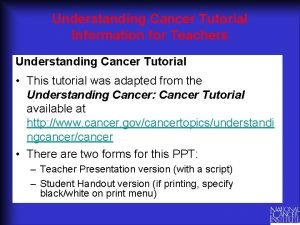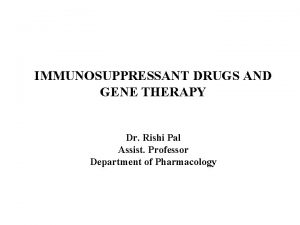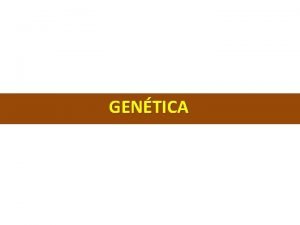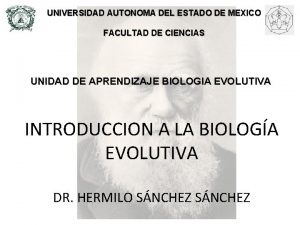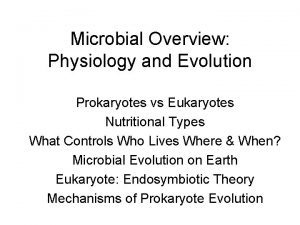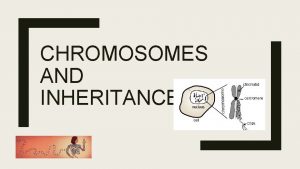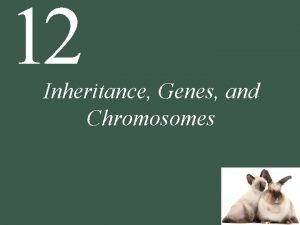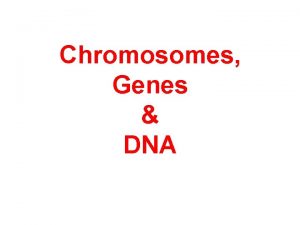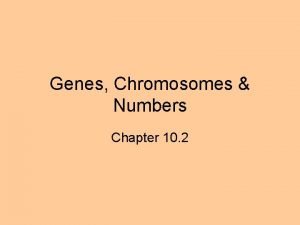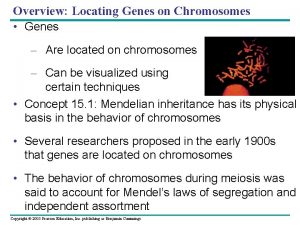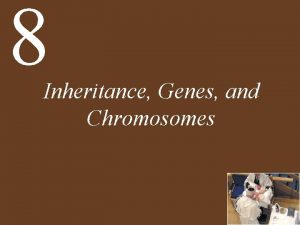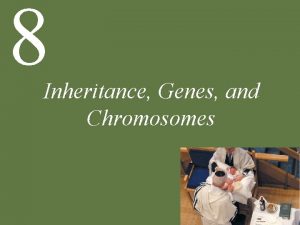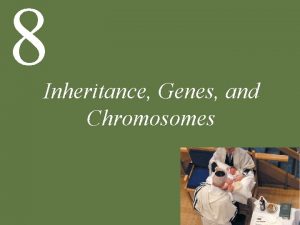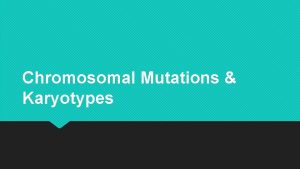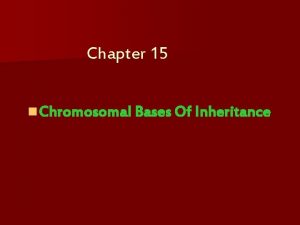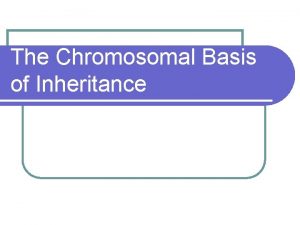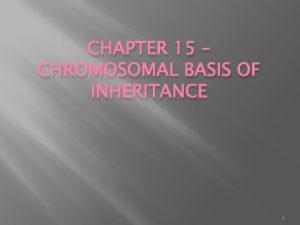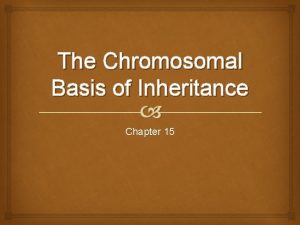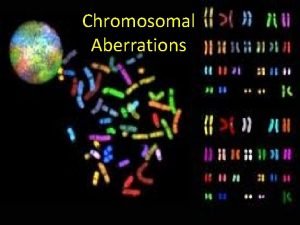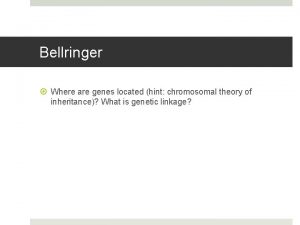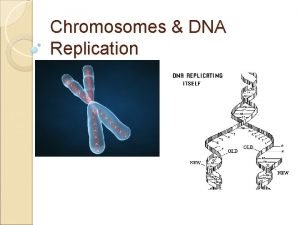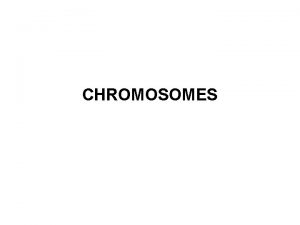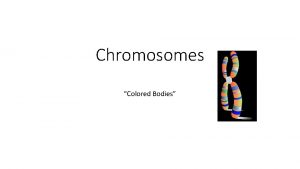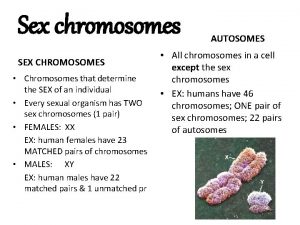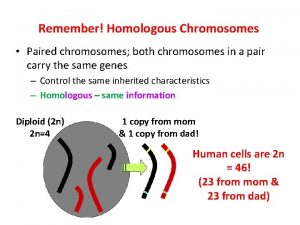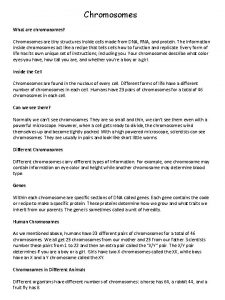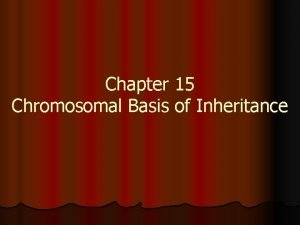Chromosomal Inheritance Genes Are located on chromosomes Can






























































- Slides: 62

Chromosomal Inheritance

• Genes – Are located on chromosomes – Can be visualized using certain techniques

• Mendelian inheritance has its physical basis in the behavior of chromosomes • Several researchers proposed in the early 1900 s that genes are located on chromosomes • The behavior of chromosomes during meiosis was said to account for Mendel’s laws of segregation and independent assortment

• The chromosome theory of inheritance states that – Mendelian genes have specific loci on chromosomes – Chromosomes undergo segregation and independent assortment

• The chromosomal basis of Mendel’s laws – The behavior of homologous chromosomes during meiosis can account for the segregation of the alleles at each genetic locus to different gametes – The behavior of nonhomologous chromosomes during meiosis can account for the independent assortment of alleles for two or more genes located on different chromosomes

• Thomas Hunt Morgan – Provided convincing evidence that chromosomes are the location of Mendel’s heritable factors

• Morgan worked with fruit flies (Drosophila melanogaster) – Because they breed at a high rate – A new generation can be bred every two weeks – They have only four pairs of chromosomes • 3 pairs of autosomes • 1 pair of sex chromosomes (XX, XY)

• Morgan first observed and noted – Wild type, or normal, phenotypes that were common in the fly populations • Traits alternative to the wild type – Are called mutant phenotypes

Correlating Behavior of a Gene’s Alleles with Behavior of a Chromosome Pair • In one experiment Morgan mated male flies with white eyes (mutant) with female flies with red eyes (wild type) – The F 1 generation all had red eyes – The F 2 generation showed the 3: 1 red: white eye ratio, but only males had white eyes

• Morgan determined – That the white-eye mutant allele must be located on the X chromosome

• Morgan’s discovery that transmission of the X chromosome in fruit flies correlates with inheritance of the eye-color trait – Was the first solid evidence indicating that a specific gene is associated with a specific chromosome

• Linked genes tend to be inherited together because they are located near each other on the same chromosome • Each chromosome – Has hundreds or thousands of genes – Results of crosses of linked genes deviate from those expected according to independent assortment

How Linkage Affects Inheritance • Morgan did other experiments with fruit flies – To see how linkage affects the inheritance of two different characters • Body color • Wing size

• Morgan crossed flies – That differed in traits of two different characters

• Morgan determined that – Genes that are close together on the same chromosome are linked and do not assort independently – Unlinked genes are either on separate chromosomes or are far apart on the same chromosome and assort independently

Recombination of Unlinked Genes: Independent Assortment of Chromosomes • When Mendel followed the inheritance of two characters – He observed that some offspring have combinations of traits that do not match either parent in the P generation

• Recombinant offspring – Are those that show new combinations of the parental traits • When 50% of all offspring are recombinants – Geneticists say that there is a 50% frequency of recombination

Recombination of Linked Genes: Crossing Over • Morgan discovered that genes can be linked – But due to the appearance of recombinant phenotypes, the linkage appeared incomplete

• Morgan proposed that – Some process must occasionally break the physical connection between genes on the same chromosome – Crossing over of homologous chromosomes was the mechanism

• Linked genes – Exhibit recombination frequencies less than 50%

Linkage Mapping: Using Recombination Data • A genetic map – Is an ordered list of the genetic loci along a particular chromosome – Can be developed using recombination frequencies

• Alfred Sturtevant – Predicted that the father apart two genes are, the higher the probability that a crossover will occur between them, and therefore, the higher the recombination frequency

• A linkage map – Is the actual map of a chromosome based on recombination frequencies – Sturtevant expressed the distance between genes, the recombination frequency, as map units • One map unit (centimorgan) is equivalent ro 1% recombination

• The farther apart genes are on a chromosome – The more likely they are to be separated during crossing over – Some genes on a chromosome are so far apart that a crossover between them is certain • The genes behave as if found on separate chromosomes

• Many fruit fly genes – were mapped initially using recombination frequencies • Linkage maps portray linear positions of genes along a chromosome – Indicate relative distance and order but not precise locations of genes • Cytogenetic maps • Physical maps

• Sex-linked genes exhibit unique patterns of inheritance

The Chromosomal Basis of Sex • An organism’s sex – Is an inherited phenotypic character determined by the presence or absence of certain chromosomes

• In humans and other mammals – There are two varieties of sex chromosomes, X and Y (X-Y system) • XX ♀ • XY ♂

• Different systems of sex determination – Are found in other organisms • X-0 system – ♂ X, ♀XX • Z-W system – ♂ZZ, ♀ZW • Haplo-diploid system – No sex chromosomes – ♂ haploid, ♀diploid

• X-Y system – The Y chromosome is much smaller than the X chromosome – The X and Y rarely cross over – Sex chromosomes segregate during meiosis and each gamete receives one

• In humans gonads develop into either ovaries or testes depending on hormonal conditions within the embryo – Depends on whether or not a Y chromosome is present • A gene on the Y chromosome is required for the development of testes • SRY (sex-determining region) – Triggers a cascade of biochemical, physiological, and anatomical features

Inheritance of Sex-Linked Genes • The sex chromosomes – Have genes for many characters unrelated to sex • A gene located on either sex chromosome – Is called a sex-linked gene – In humans, the term refers to a gene on the X chromosome

• Sex-linked genes – Follow specific patterns of inheritance – In humans • If the sex-linked trait is due to a recessive allele – A female will express the phenotype only if she is homozygous – Heterozygous females are carriers – Males are hemizygous

• Some recessive alleles found on the X chromosome in humans cause certain types of disorders – Color blindness – Duchenne muscular dystrophy – Hemophilia

X inactivation in Female Mammals • In mammalian females – One of the two X chromosomes in each cell is randomly inactivated during embryonic development • DNA is modified by the addition of methyl groups (methylation) • the X chromosome condenses into a compact object called the Barr body – Therefore, males and females have the same effective dose (one copy) of genes on the X chromosome

• Females consist of a mosaic of two types of cells – Some cells with an active paternal X chromosome, other with an active maternal X chromosome – If a female is heterozygous for a particular gene located on the X chromosome, she will be a mosaic for that character • Distribution of sweat glands in human females • Orange-and-black pattern on tortoiseshell cats

• XIST gene (X-inactive specific transcript) – Only active in the Barr body – Produces multiple copies of RNA molecules that attach to the X-chromosome

• Alterations of chromosome number or structure cause some genetic disorders • Large-scale chromosomal alterations – Often lead to spontaneous abortions or cause a variety of developmental disorders

Abnormal Chromosome Number • When nondisjunction occurs – Pairs of homologous chromosomes do not separate normally during meiosis – Gametes contain two copies or no copies of a particular chromosome

• Aneuploidy – Results from the fertilization of gametes in which nondisjunction occurred – Is a condition in which offspring have an abnormal number of a particular chromosome

• If a zygote is trisomic – It has three copies of a particular chromosome • If a zygote is monosomic – It has only one copy of a particular chromosome

• Polyploidy – Is a condition in which there are more than two complete sets of chromosomes in an organism • 3 sets – triploid (3 n) • 4 sets – tetraploid (4 n)

• Polyploidy is relatively common in plants – Important in the evolution of plants • Less common among animals – Fishes, amphibians

Alterations of Chromosome Structure • Breakage of a chromosome can lead to four types of changes in chromosome structure – Deletion – Duplication – Inversion – Translocation

• Alterations of chromosome structure – deletion - removes a chromosomal segment. – duplication - repeats a segment. – inversion - reverses a segment within a chromosome.

• Alterations of chromosome structure – translocation - moves a segment from one chromosome to another, nonhomologous one. • In a reciprocal translocation, the most common type, nonhomologous chromosomes exchange fragments. • Nonreciprocal translocation also occur, in which a chromosome transfers a fragment without receiving a fragment in return.

Human Disorders Due to Chromosomal Alterations • Alterations of chromosome number and structure – Are associated with a number of serious human disorders

Aneuploidy of autosomal chromosomes • Down syndrome – trisomy 21 – the result of an extra chromosome 21

Maternal Age and Down Syndrome

• Edwards syndrome – trisonomy 18 • Patau syndrome – trisonomy 13

Aneuploidy of Sex Chromosomes • Nondisjunction of sex chromosomes – Produces a variety of aneuploid conditions

• Klinefelter syndrome – Is the result of an extra X chromosome in a male, producing XXY individuals • Turner syndrome – Is the result of monosomy X, producing an X 0 karyotype

• Metafemale • Is the result of trisonomy X, producing an XXX female • Jacob syndrome – Is the result of an extra Ychromosome in a male, producing XYY individuals

Disorders Caused by Structurally Altered Chromosomes • Cri du chat – Is a disorder caused by a specific deletion in chromosome 5

• Certain cancers – Are caused by translocations of chromosomes • chronic myelogenous leukemia (CML) • A large fragment of chromosome 22 switches places with a small fragment from the tip of chromosome 9 (Philadelphia chromosome)

Genomic Imprinting • In mammals – The phenotypic effects of certain genes depend on which allele is inherited from the mother and which is inherited from the father

• Genomic imprinting – Involves the silencing of certain genes that are “stamped” with an imprint during gamete production • Imprinted genes are not expressed

• Maternally imprinted gene – Only paternal allele is expressed • Paternally imprinted gene – Only maternal gene is expressed • In many cases, methylation silences an allele – methyl groups (-CH 3) are added to the cytosine nucleotide of one of the alleles

• Some inheritance patterns are exceptions to the standard chromosome theory • Exhibit a non-Mendelian inheritance pattern – Genes located outside the nucleus • Extranuclear genes

Inheritance of Organelle Genes • Extranuclear genes – Are genes found in organelles in the cytoplasm • Chloroplasts • mitochondria

• The inheritance of traits controlled by genes present in the chloroplasts or mitochondria • Depends solely on the maternal parent because the zygote’s cytoplasm comes from the egg – Maternal inheritance • In animals the zygote inherits all mitochondrial from the ovum

• Some diseases affecting the muscular and nervous systems – Are caused by defects in mitochondrial genes that prevent cells from making enough ATP • mitochondrial myopathy
 Genes located on the sex chromosomes
Genes located on the sex chromosomes Mikael ferm
Mikael ferm 15/16
15/16 The chromosomal basis of inheritance chapter 15
The chromosomal basis of inheritance chapter 15 Chapter 15 the chromosomal basis of inheritance
Chapter 15 the chromosomal basis of inheritance Chromosomal theory of inheritance
Chromosomal theory of inheritance Chapter 15 the chromosomal basis of inheritance
Chapter 15 the chromosomal basis of inheritance Linked genes and unlinked genes
Linked genes and unlinked genes Homeotic genes
Homeotic genes Linked genes and unlinked genes
Linked genes and unlinked genes Genes chromosomes and dna
Genes chromosomes and dna Dna chromosomes genes diagram
Dna chromosomes genes diagram What is the relationship between dna chromosomes and genes
What is the relationship between dna chromosomes and genes Genetics foldable
Genetics foldable Dna, genes and chromosomes relationship
Dna, genes and chromosomes relationship Genes chromosomes dna
Genes chromosomes dna Section 12-1 chromosomes and inheritance
Section 12-1 chromosomes and inheritance Chromosome function
Chromosome function Chromosomal nondisjunction results in
Chromosomal nondisjunction results in Types of mutations
Types of mutations Genetic disorders
Genetic disorders Mutation is any mistake or change in the
Mutation is any mistake or change in the Chromosome mutation
Chromosome mutation Chromosomal mutation
Chromosomal mutation Chromosomal mutation deletion
Chromosomal mutation deletion Difference between mendelian and chromosomal disorders
Difference between mendelian and chromosomal disorders Chromosome dna function
Chromosome dna function What type of mutation is cri du chat syndrome
What type of mutation is cri du chat syndrome Chromosomal mutation
Chromosomal mutation Incomplete abortion
Incomplete abortion Chromosomal arrangement
Chromosomal arrangement Deletion chromosomal mutation
Deletion chromosomal mutation Chromosomal abnormalities occur when a zygote's cells have
Chromosomal abnormalities occur when a zygote's cells have Chromosome 13 abnormality
Chromosome 13 abnormality Chromosomal crossover
Chromosomal crossover Permanent alteration
Permanent alteration Tautomeric shift mutation
Tautomeric shift mutation Chromosomal abnormalities miscarriage
Chromosomal abnormalities miscarriage Cri du chat chromosomal abnormalities
Cri du chat chromosomal abnormalities Translocation
Translocation Chromosomal mutation images
Chromosomal mutation images What are some types of chromosomal mutations?
What are some types of chromosomal mutations? Jumping genes
Jumping genes Dna and genes chapter 11
Dna and genes chapter 11 Dna genes
Dna genes Telomerasa
Telomerasa Convergent evolution
Convergent evolution Genes e ambiente
Genes e ambiente Floral homeotic genes
Floral homeotic genes A lac repressor turns off the lac genes by
A lac repressor turns off the lac genes by Non protein coding genes
Non protein coding genes Bill nye genes youtube
Bill nye genes youtube The age of genes chapter 6
The age of genes chapter 6 Genes hox
Genes hox Que son genes
Que son genes Los transposones son genes móviles en un cromosoma
Los transposones son genes móviles en un cromosoma Tumor suppressor genes
Tumor suppressor genes Genes
Genes Nevertheless part 3
Nevertheless part 3 Alelos
Alelos Macroevolucion
Macroevolucion Linked genes punnett square
Linked genes punnett square Jumping genes
Jumping genes


